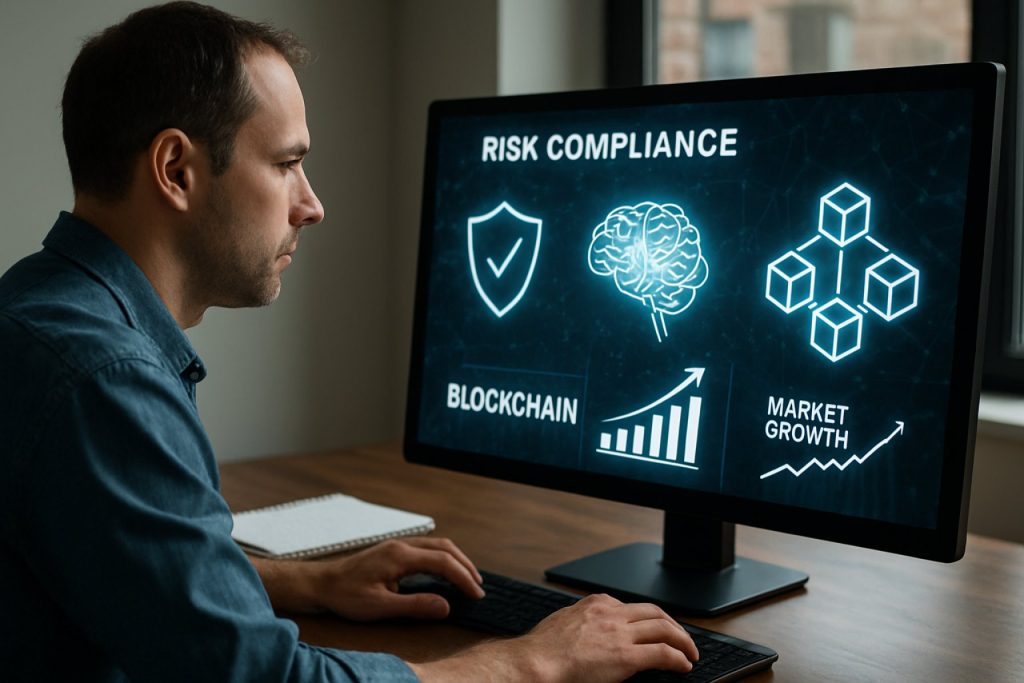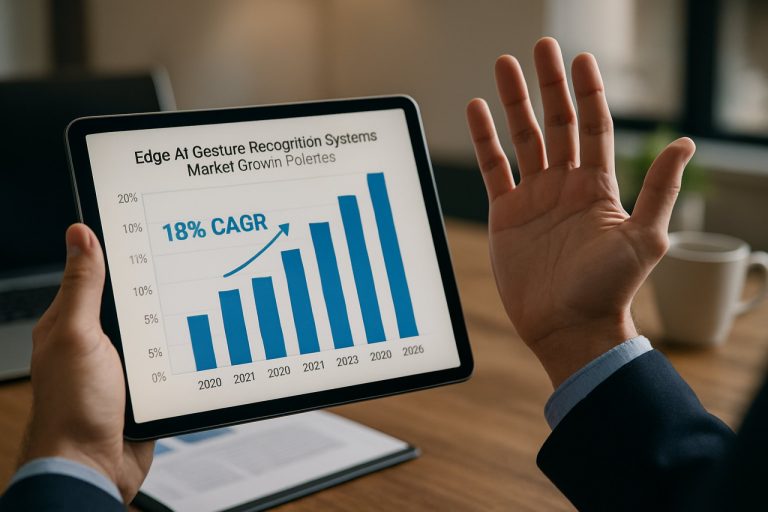
Risk Compliance Automation in Blockchain 2025: Navigating AI-Enabled Transformation and Regulatory Demands. This report delivers in-depth analysis of market trends, growth forecasts, and strategic opportunities shaping the next five years.
- Executive Summary and Market Overview
- Key Technology Trends in Blockchain Risk Compliance Automation
- Competitive Landscape and Leading Solution Providers
- Market Growth Forecasts and Revenue Projections (2025–2030)
- Regional Analysis: Adoption Patterns and Regulatory Drivers
- Future Outlook: Emerging Use Cases and Innovation Pathways
- Challenges, Risks, and Strategic Opportunities for Stakeholders
- Sources & References
Executive Summary and Market Overview
Risk compliance automation in blockchain refers to the deployment of automated tools and systems that ensure blockchain-based operations adhere to regulatory requirements, industry standards, and internal policies. As blockchain adoption accelerates across sectors such as finance, supply chain, and healthcare, the complexity and volume of compliance obligations have increased, driving demand for automated solutions that can monitor, detect, and report compliance risks in real time.
By 2025, the global market for risk compliance automation in blockchain is projected to experience robust growth, fueled by tightening regulatory scrutiny, the proliferation of decentralized finance (DeFi), and the expansion of cross-border digital asset transactions. According to Gartner, worldwide blockchain spending is expected to reach $19 billion in 2025, with a significant portion allocated to compliance and security solutions. The increasing sophistication of anti-money laundering (AML), know-your-customer (KYC), and transaction monitoring requirements has made manual compliance processes unsustainable, especially for enterprises operating at scale.
Key drivers of this market include the emergence of regulatory frameworks such as the European Union’s Markets in Crypto-Assets Regulation (MiCA) and the Financial Action Task Force (FATF) guidelines, which mandate robust compliance controls for blockchain-based entities. Automated compliance platforms leverage artificial intelligence, machine learning, and smart contracts to streamline risk assessments, flag suspicious activities, and generate audit trails, reducing operational costs and minimizing human error. Leading technology providers such as IBM, Chainalysis, and Elliptic are at the forefront, offering integrated solutions that cater to both public and private blockchain environments.
- Financial institutions are increasingly adopting automated compliance tools to manage the risks associated with digital asset custody, trading, and settlement.
- Regtech startups are innovating with blockchain-native compliance modules, enabling real-time regulatory reporting and adaptive risk scoring.
- Enterprises are prioritizing interoperability and scalability in compliance automation, seeking solutions that can adapt to evolving regulatory landscapes across jurisdictions.
In summary, risk compliance automation in blockchain is transitioning from a niche capability to a core requirement for organizations leveraging distributed ledger technologies. The market outlook for 2025 is characterized by rapid innovation, regulatory alignment, and growing investment in intelligent compliance infrastructure.
Key Technology Trends in Blockchain Risk Compliance Automation
Risk compliance automation in blockchain is rapidly evolving, driven by the increasing adoption of distributed ledger technologies across regulated industries such as finance, healthcare, and supply chain. In 2025, organizations are leveraging advanced automation tools to address the complex and dynamic regulatory landscape, reduce manual intervention, and enhance transparency in compliance processes.
One of the most significant trends is the integration of artificial intelligence (AI) and machine learning (ML) with blockchain platforms to automate compliance monitoring and reporting. These technologies enable real-time analysis of on-chain transactions, flagging suspicious activities and ensuring adherence to anti-money laundering (AML) and know-your-customer (KYC) regulations. For example, AI-powered compliance engines can automatically detect anomalies and generate audit trails, reducing the risk of human error and improving regulatory response times. According to Gartner, by 2026, 80% of blockchain projects will incorporate automated compliance features, up from less than 20% in 2023.
Another key trend is the adoption of smart contracts for compliance enforcement. Smart contracts can encode regulatory requirements directly into blockchain transactions, ensuring that only compliant transactions are executed. This approach minimizes the need for manual compliance checks and provides immutable records for regulators and auditors. Leading blockchain platforms, such as those developed by IBM and Microsoft, are increasingly offering compliance modules that integrate with existing enterprise systems.
Interoperability and standardization are also gaining traction, as organizations seek to streamline compliance across multiple jurisdictions and blockchain networks. Industry consortia, such as the R3 consortium, are working on standardized compliance frameworks that facilitate cross-border regulatory reporting and data sharing while maintaining privacy and security.
Finally, regulatory technology (RegTech) startups are playing a pivotal role in advancing blockchain risk compliance automation. Companies like Chainalysis and Elliptic provide automated risk assessment and transaction monitoring solutions tailored for blockchain assets, helping enterprises and financial institutions meet evolving compliance requirements efficiently.
Competitive Landscape and Leading Solution Providers
The competitive landscape for risk compliance automation in blockchain is rapidly evolving as regulatory scrutiny intensifies and enterprises seek robust, scalable solutions. By 2025, the market is characterized by a mix of established technology firms, specialized blockchain compliance startups, and major consulting organizations, all vying to address the complex needs of financial institutions, crypto exchanges, and decentralized finance (DeFi) platforms.
Key players in this space include Chainalysis, Elliptic, and TRM Labs, each offering advanced risk monitoring, transaction screening, and anti-money laundering (AML) automation tools tailored for blockchain environments. These companies leverage machine learning and large-scale blockchain analytics to provide real-time risk scoring, wallet attribution, and automated compliance reporting, enabling clients to meet evolving regulatory requirements efficiently.
Traditional compliance technology providers such as Nasdaq Verafin and Refinitiv have expanded their offerings to include blockchain-specific modules, integrating on-chain data with existing know-your-customer (KYC) and transaction monitoring systems. This convergence allows financial institutions to manage both fiat and crypto compliance risks within unified platforms, streamlining operations and reducing manual intervention.
Consulting giants like Deloitte and PwC are also active, providing advisory services and custom automation frameworks for large-scale blockchain deployments. Their solutions often focus on integrating regulatory technology (RegTech) with enterprise blockchain infrastructure, ensuring end-to-end compliance from smart contract development to transaction execution.
Emerging startups such as ComplyAdvantage and IdentityMind are gaining traction by offering API-driven compliance automation, real-time sanctions screening, and risk scoring for decentralized applications (dApps) and NFT marketplaces. These agile providers are particularly attractive to Web3 projects seeking rapid deployment and modular compliance capabilities.
- Market consolidation is expected as larger firms acquire niche startups to expand their blockchain compliance portfolios.
- Interoperability and integration with legacy systems remain key differentiators among leading solution providers.
- Continuous updates to regulatory frameworks, such as the EU’s MiCA and the US’s evolving crypto regulations, drive innovation and competition in automated compliance tools.
Overall, the 2025 risk compliance automation landscape in blockchain is defined by technological sophistication, regulatory adaptability, and a growing emphasis on seamless integration across both traditional and decentralized financial ecosystems.
Market Growth Forecasts and Revenue Projections (2025–2030)
The market for risk compliance automation in blockchain is poised for significant expansion in 2025, driven by increasing regulatory scrutiny, the proliferation of digital assets, and the need for robust, scalable compliance solutions. According to projections by Gartner, global spending on blockchain solutions is expected to surpass $19 billion in 2024, with a substantial portion allocated to compliance and risk management tools. This trend is anticipated to accelerate in 2025 as financial institutions, fintechs, and enterprises seek to automate anti-money laundering (AML), know-your-customer (KYC), and transaction monitoring processes to meet evolving regulatory requirements.
Revenue from risk compliance automation platforms leveraging blockchain is forecasted to grow at a compound annual growth rate (CAGR) of 22–28% between 2025 and 2030, according to MarketsandMarkets. In 2025 alone, the segment is projected to generate approximately $2.1 billion in global revenue, up from an estimated $1.6 billion in 2024. This growth is underpinned by the adoption of smart contract-based compliance protocols, real-time risk analytics, and cross-border regulatory reporting solutions.
- Financial Services: The banking and financial services sector will remain the largest adopter, accounting for over 45% of total market revenue in 2025, as per IDC. The sector’s focus on automating compliance for digital asset custody, decentralized finance (DeFi), and tokenized securities is a key driver.
- Geographic Trends: North America and Europe are expected to lead in market share, with Asia-Pacific showing the fastest growth due to regulatory modernization and increased blockchain adoption in financial hubs like Singapore and Hong Kong.
- Vendor Landscape: Major technology providers and RegTech startups are intensifying investments in AI-driven compliance automation, with notable players including IBM, Chainalysis, and Elliptic.
Looking ahead, the convergence of blockchain with AI and machine learning is expected to further enhance the accuracy and efficiency of risk compliance automation, supporting sustained double-digit revenue growth through 2030.
Regional Analysis: Adoption Patterns and Regulatory Drivers
The adoption of risk compliance automation in blockchain is exhibiting distinct regional patterns in 2025, shaped by regulatory frameworks, technological maturity, and market demand. North America, particularly the United States, leads in implementation due to proactive regulatory engagement and a robust fintech ecosystem. The U.S. Securities and Exchange Commission and FINRA have issued clear guidelines on digital asset compliance, prompting financial institutions and blockchain startups to invest in automated solutions for anti-money laundering (AML), know-your-customer (KYC), and transaction monitoring. This regulatory clarity has accelerated the deployment of compliance automation platforms, with vendors like Chainalysis and Elliptic reporting increased adoption among U.S.-based clients.
In Europe, the introduction of the Markets in Crypto-Assets Regulation (MiCA) by the European Securities and Markets Authority is a significant driver. MiCA’s comprehensive requirements for crypto-asset service providers have led to a surge in demand for automated compliance tools that can adapt to evolving standards across EU member states. Countries like Germany, Switzerland, and France are at the forefront, leveraging automation to streamline cross-border compliance and reporting. According to Statista, the European blockchain compliance market is projected to grow at a CAGR of over 20% through 2025, outpacing some other regions due to regulatory harmonization.
Asia-Pacific presents a mixed landscape. Singapore and Japan have established themselves as regulatory innovators, with the Monetary Authority of Singapore and Japan Financial Services Agency fostering environments conducive to blockchain adoption. These countries are seeing rapid uptake of compliance automation, particularly among exchanges and digital banks. Conversely, China’s restrictive stance on cryptocurrencies has limited the scope of blockchain risk compliance automation, though enterprise blockchain applications in supply chain and trade finance are still leveraging automated compliance for internal controls.
In Latin America and Africa, adoption is nascent but growing, driven by the need to address financial crime and regulatory gaps. Initiatives by the Financial Action Task Force (FATF) are influencing local regulators to mandate compliance automation, especially in high-risk jurisdictions. However, infrastructure and resource constraints remain barriers to widespread implementation.
Overall, regional adoption patterns in 2025 are closely tied to regulatory drivers, with jurisdictions offering clear, supportive frameworks experiencing the fastest growth in risk compliance automation for blockchain.
Future Outlook: Emerging Use Cases and Innovation Pathways
Looking ahead to 2025, the landscape for risk compliance automation in blockchain is poised for significant transformation, driven by both regulatory evolution and technological innovation. As global authorities intensify their scrutiny of digital assets, blockchain platforms are increasingly integrating advanced compliance automation tools to address anti-money laundering (AML), know-your-customer (KYC), and counter-terrorism financing (CTF) requirements. The convergence of artificial intelligence (AI), machine learning, and blockchain is enabling real-time monitoring and anomaly detection, reducing manual intervention and operational costs.
Emerging use cases are particularly prominent in decentralized finance (DeFi), where automated compliance protocols are being embedded directly into smart contracts. This allows for continuous, on-chain verification of user identities and transaction histories, ensuring regulatory adherence without compromising decentralization. For example, protocols are leveraging zero-knowledge proofs to validate compliance data while preserving user privacy, a critical innovation as privacy regulations tighten worldwide. Additionally, cross-chain interoperability solutions are being developed to facilitate seamless compliance checks across multiple blockchain networks, addressing the growing complexity of multi-chain ecosystems.
Financial institutions and enterprises are also exploring blockchain-based compliance automation for supply chain transparency, trade finance, and digital identity management. By automating risk assessments and audit trails, these solutions enhance trust and reduce the risk of fraud or regulatory breaches. The integration of oracles and external data feeds is further expanding the scope of automated compliance, enabling smart contracts to react dynamically to regulatory changes or real-world events.
- In 2025, the adoption of RegTech solutions tailored for blockchain is expected to accelerate, with the global RegTech market projected to reach $28.3 billion by 2027, driven in part by blockchain innovation (MarketsandMarkets).
- Major blockchain analytics firms are expanding their offerings to include automated risk scoring and compliance reporting, catering to both crypto-native and traditional financial clients (Chainalysis).
- Regulatory sandboxes and pilot programs are fostering collaboration between regulators, technology providers, and financial institutions, accelerating the development and deployment of automated compliance frameworks (Financial Conduct Authority).
As regulatory expectations continue to evolve, the future of risk compliance automation in blockchain will hinge on the ability to balance robust oversight with the core principles of decentralization and privacy. The next wave of innovation is likely to focus on adaptive, interoperable, and privacy-preserving compliance solutions, setting new standards for trust and transparency in the digital economy.
Challenges, Risks, and Strategic Opportunities for Stakeholders
The integration of risk compliance automation within blockchain ecosystems presents a complex landscape of challenges, risks, and strategic opportunities for stakeholders in 2025. As regulatory scrutiny intensifies and blockchain adoption accelerates across industries, organizations must navigate evolving compliance requirements while leveraging automation to enhance efficiency and transparency.
Challenges and Risks
- Regulatory Uncertainty: The global regulatory environment for blockchain remains fragmented, with jurisdictions such as the European Union, United States, and Asia-Pacific implementing divergent frameworks. This lack of harmonization complicates the automation of compliance processes, as solutions must adapt to varying standards and frequent updates (Deloitte).
- Data Privacy and Security: Automated compliance tools must process sensitive transactional and identity data. Ensuring data privacy, especially under regulations like GDPR, and safeguarding against cyber threats are persistent concerns. Breaches or non-compliance can result in significant financial and reputational damage (PwC).
- Interoperability and Integration: Many organizations operate hybrid environments, combining legacy systems with blockchain platforms. Seamless integration of automated compliance tools across these systems is technically challenging and can hinder real-time risk monitoring (IBM).
- False Positives and Algorithmic Bias: Automated systems may generate false positives or exhibit bias in risk assessments, leading to unnecessary investigations or overlooked threats. Continuous model validation and human oversight are required to maintain accuracy (Accenture).
Strategic Opportunities
- Real-Time Compliance Monitoring: Automation enables continuous, real-time monitoring of transactions and smart contracts, reducing manual workloads and improving detection of suspicious activities. This capability is particularly valuable for financial institutions and supply chain operators (Deloitte).
- Cost Reduction and Scalability: Automated compliance processes can significantly lower operational costs and scale more efficiently than manual approaches, supporting rapid business growth and cross-border operations (McKinsey & Company).
- Enhanced Transparency and Auditability: Blockchain’s immutable ledger, combined with automated compliance, offers stakeholders greater transparency and facilitates regulatory audits, fostering trust among partners and regulators (EY).
Sources & References
- IBM
- Chainalysis
- Elliptic
- TRM Labs
- Deloitte
- PwC
- IdentityMind
- MarketsandMarkets
- IDC
- FINRA
- European Securities and Markets Authority
- Statista
- Monetary Authority of Singapore
- Japan Financial Services Agency
- Financial Conduct Authority
- Accenture
- McKinsey & Company
- EY



